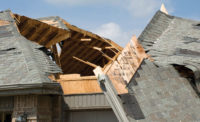Jeff Petrucci has been a roofing contractor for more than 20 years. Seven years ago, he decided to transition into insurance restoration work, mainly dealing with flooding. That’s when Jeff, the president of Bloomfield Construction in Bloomfield Hills, Mich., discovered there was a big need for a contractor who understood the restoration portion of roofing projects.
“It’s rare to find a roofing company that does restoration work,” Petrucci said. “We’ve kind of got an advantage, I feel. I’ve been told we know the exterior parts of a home better than any restoration company.”
That knowledge of homes from the outside, in, really came into play when Petrucci and his team tackled a large-scale roofing restoration project in West Bloomfield, Mich., during what felt like an especially long winter. Tremendous ice dams formed, leading to improper ventilation and a lack of insulation. That led to a lot of interior damage including drywall, paint and hardwood floors. Due to cathedral ceilings, workers chose to remove all the plywood and fiberglass insulation from the top, rather than remove all the drywall from the inside. Then, they added 6 inches of closed-cell foam, sprayed against the back side of the drywall, installed new plywood, shingles and rebuilt the chimney that was falling apart.
“The job looks great and the ice dams are now solved. Part of this job was paid by insurance and part was a private pay by the customer. We call this job a hybrid,” Pertucci explained. He said many restoration contractors wouldn’t get involved in this type of roofing project because of its complexity. “These are right up our alley… the more involved and the more skillsets required, the more it suits us!”
When Petrucci gets a call from an insurance company or customer, he says it’s about more than just giving the customer a quote.
“We do, I would say, a more thorough investigation than many roofing companies. For example, we ask ourselves ‘why did the shingles blow off?’ If there are 50 mile-per-hour winds, they shouldn’t have blown off.” Petrucci went on to explain, “(the shingles) were likely not nailed down or glued properly. Sometimes insurance companies can deny coverage for that. Less than 110 mile-per-hour winds, they shouldn’t blow off.”
And for Petrucci, his trained people are what make his company successful.
“Working with every guy who looks at roofs for me. Making them take digital photos of everything so we have a history from the first inspection, look at the attic, etc… a timeline of photos of things that are possibly going bad. If you train people to look for those things in the beginning, you’ll save a lot of headaches down the road,” Petrucci said. “Too many people go into a home and give an estimate – not problem-solving and giving solutions. They’re just changing the color of the roof. That’s not my business model, not the way I take care of my customers and have longevity.”






Report Abusive Comment